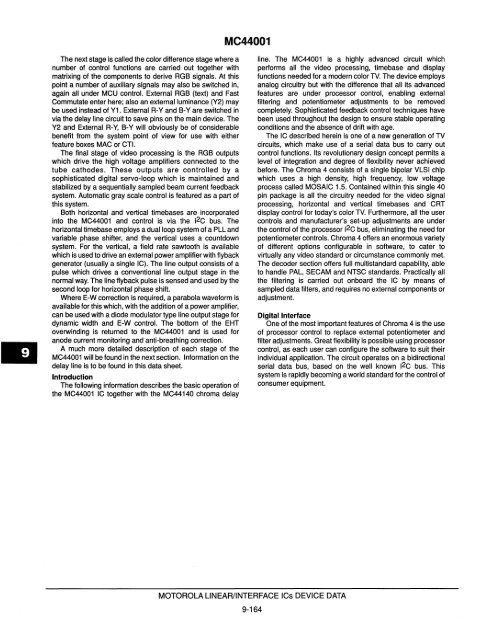Voltage References
Voltage References
Voltage References
Create successful ePaper yourself
Turn your PDF publications into a flip-book with our unique Google optimized e-Paper software.
The next stage is called the color difference stage where a<br />
number of control functions are carried out together with<br />
matrixing of the components to derive RGB signals. At this<br />
point a number of auxiliary signals may also be switched in,<br />
again all under MCU control. External RGB (text) and Fast<br />
Commutate enter here; also an external luminance (V2) may<br />
be used instead of VI. External R-V and B-V are switched in<br />
via the delay line circuit to save pins on the main device. The<br />
V2 and External R-V, B-V will obviously be of considerable<br />
benefit from the system point of view for use with either<br />
feature boxes MAC or CTI.<br />
The final stage of video processing is the RGB outputs<br />
which drive the high voltage amplifiers connected to the<br />
tube cathodes. These outputs are controlled by a<br />
sophisticated digital servo-loop which is maintained and<br />
stabilized by a sequentially sampled beam current feedback<br />
system. Automatic gray scale control is featured as a part of<br />
this system.<br />
Both horizontal and vertical timebases are incorporated<br />
into the MC44001 and control is via the 12C bus. The<br />
horizontaltimebase employs a dual loop system of a PLL and<br />
variable phase shifter, and the vertical uses a countdown<br />
system. For the vertical, a field rate sawtooth is available<br />
which is used to drive an external power amplifier with flyback<br />
generator (usually a single IC). The line output consists of a<br />
pulse which drives a conventional line output stage in the<br />
normal way. The line flyback pulse is sensed and used by the<br />
second loop for horizontal phase shift.<br />
Where E-W correction is required, a parabola waveform is<br />
available for this which, with the addition of a power amplifier,<br />
can be used with a diode modulator type line output stage for<br />
dynamic width and E-W control. The bottom of the EHT<br />
overwinding is returned to the MC44001 and is used for<br />
anode current monitoring and'anti-breathing correction.<br />
A much more detailed description of each stage of the<br />
MC44001 will be found in the next section. Information on the<br />
delay line is to be found in this data sheet.<br />
Introduction<br />
The following information describes the basic operation of<br />
the MC44001 IC together with the MC44140 chroma delay<br />
MC44001<br />
MOTOROLA LINEAR/INTERFACE ICs DEVICE DATA<br />
9-164<br />
line. The MC44001 is a highly advanced circuit which<br />
performs all the video processing, timebase and display<br />
functions needed for a modern color TV. The device employs<br />
analog circuitry but with the difference that all its advanced<br />
features are under processor control, enabling external<br />
filtering and potentiometer adjustments to be removed<br />
completely. Sophisticated feedback control techniques have<br />
been used throughout the design to ensure stable operating<br />
conditions and the absence of drift with age.<br />
The IC described herein is one of a new generation of TV<br />
circuits, which make use of a serial data bus to carry out<br />
control functions. Its revolutionary design concept permits a<br />
level of integration and degree of flexibility never achieved<br />
before. The Chroma 4 consists of a single bipolar VLSI chip<br />
which uses a high density, high frequency, low voltage<br />
process called MOSAIC 1.5. Contained within this single 40<br />
pin package is all the circuitry needed for the video signal<br />
processing, horizontal and vertical timebases and CRT<br />
display control for today's color TV. Furthermore, all the user<br />
controls and manufacturer's set-up adjustments are under<br />
the control of the processor 12C bus, eliminating the need for<br />
potentiometer controls. Chroma 4 offers an enormous variety<br />
of different options configurable in software, to cater to<br />
virtually any video standard or circumstance commonly met.<br />
The decoder section offers full multistandard capability, able<br />
to handle PAL, SECAM and NTSC standards. Practically all<br />
the filtering is carried out onboard the IC by means of<br />
sampled data filters, and requires no external components or<br />
adjustment.<br />
Digital Interface<br />
One of the most important features of Chroma 4 is the use<br />
of processor control to replace external potentiometer and<br />
filter adjustments. Great flexibility is possible using processor<br />
control, as each user can configure the software to suit their<br />
individual application. The circuit operates on a bidirectional<br />
serial data bus, based on the well known 12C bus. This<br />
system is rapidly becoming a world standard for the control of<br />
consumer equipment.

















